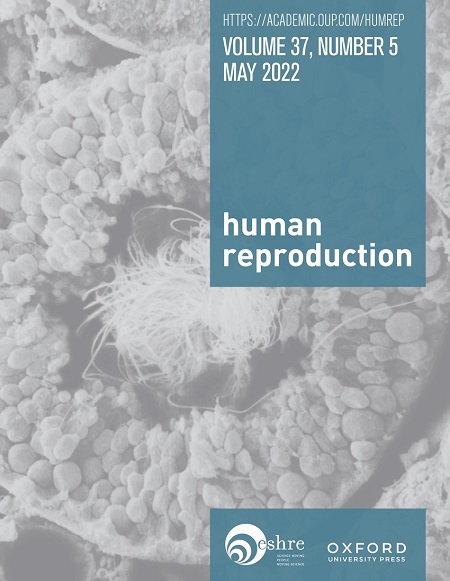美国性和性别少数的成年人使用的家庭建设方法
IF 6
1区 医学
Q1 OBSTETRICS & GYNECOLOGY
引用次数: 0
摘要
研究问题:性少数和性别少数(SGM)的父母用什么方法来建立他们的家庭?SGM父母构建家庭的方式多种多样,因性别认同和年龄而异。尽管在成为父母方面遇到了很大的障碍,但63%的年龄在18-35岁的SGM成年人正在考虑要孩子或扩大家庭规模。关于美国同性伴侣的数据表明,尽管大多数同性父母(68%)与他们的孩子有基因关系,但与异性伴侣相比,他们更有可能收养、寄养和成为继父母。研究设计、规模、持续时间PRIDE研究2018-2020年数据的横断面分析,该研究是一项针对生活在美国的SGM成年人的社区参与纵向队列研究。该分析包括2122名SGM父母和4712名子女(每名父母2名子女的中位数)。参与者/材料、环境、方法主要暴露于SGM亚组(顺性少数男性、顺性少数女性、出生时被指定为女性的性别多样化人群[AFAB]、出生时被指定为男性的性别多样化人群[AMAB]、变性男性和变性女性)和年龄队列(18-39岁、40-54岁和55岁及以上)。主要结果是建立家庭的方法,分为三个主要类别,定义为:(1)性行为导致的怀孕,(2)无性行为导致的怀孕(例如使用供体配子、代孕),以及(3)非怀孕的方法(例如收养、寄养、继子女)。我们使用逻辑回归模型来评估SGM亚组和年龄组在家庭建设方法上的差异。总体而言,56%的SGM成年人通过性行为怀孕成为父母,14%通过没有性行为的怀孕成为父母,28%通过怀孕以外的方式成为父母。与顺性女性相比,变性女性、性别多样化的父母和顺性男性通过性行为怀孕成为父母的几率更高,而在没有性行为的情况下怀孕成为父母的可能性更小。相反,与顺性女性相比,跨性别男性通过性行为怀孕的可能性更小(aOR 0.57, 95% CI 0.44, 0.73),使用非怀孕方法怀孕的可能性是其两倍多(aOR 2.39, 95% CI 1.86, 3.06)。18-39岁和40-54岁的父母在没有性行为的情况下怀孕的可能性是55岁以上父母的两倍(18-39岁:aOR 2.16, 95% CI: 1.55, 2.99;年龄40-54岁:aOR 1.92, 95% CI: 1.39, 2.66)。我们的方便样本以白色为主。我们无法推断出关于首选方法或尝试过但不成功的家庭建设方法的信息。研究结果的更广泛意义考虑到年轻一代更有可能认同为SGM,渴望孩子,并有机会获得医学辅助生殖,SGM父母的数量可能会增加。临床医生必须意识到SGM父母成为父母的方法的多样性,以及SGM人群在建立家庭时所面临的经济、法律和制度障碍。研究经费/竞争利益(S)本研究的经费由斯坦福妇幼健康研究所种子基金项目提供给J.O.M.和S.L.以及斯坦福大学医学院妇产科。本文中报告的研究部分由以患者为中心的结果研究所(PCORI)奖(奖励编号PPRN-1501-26848)资助给M.R.L.。本文中的陈述完全由作者负责,并不一定代表PCORI、其理事会或方法委员会或美国国立卫生研究院的观点。J.O.M.得到了国家糖尿病、消化和肾脏疾病研究所的部分支持[资助号K12DK111028]。A.F.得到了国家药物滥用研究所的部分资助[资助号K23DA039800]。资助方在研究设计中没有作用;数据收集、分析和解释;报告的撰写;提交文章发表的决定;或者是手稿的准备。Obedin-Maliver博士已收到Ibis Reproductive Health、Hims and Hers Health Inc.、Folx Health Inc.、Sage Therapeutics和Upstream Inc.与本研究无关的主题的资助和咨询费。Lunn博士从Hims and Hers Health Inc.、Folx Health Inc.、Otsuka Pharmaceutical Development and commercial, Inc.和美国牙科协会(American Dental Association)收取与本工作无关的咨询费。所有其他作者没有利益冲突需要报告。试验注册号无。本文章由计算机程序翻译,如有差异,请以英文原文为准。
Methods of family building used by sexual and gender minority adults in the United States
STUDY QUESTION What methods are used by sexual and gender minority (SGM) parents to build their families? SUMMARY ANSWER SGM parents used diverse methods to build their families, which varied both by gender identity and age. WHAT IS KNOWN ALREADY Despite experiencing significant barriers to becoming parents, 63% of SGM adults aged 18–35 years old are considering having children or expanding their family. Data on US same-sex couples demonstrate that although most same-sex parents (68%) are genetically related to their children, they are more likely to adopt, foster, and be step-parents compared with different-sex couples. STUDY DESIGN, SIZE, DURATION Cross-sectional analysis of 2018–2020 data from The PRIDE Study, a community-engaged longitudinal cohort study of SGM adults living in the USA. This analysis included 2122 SGM parents with 4712 children (median of 2 children per parent). PARTICIPANTS/MATERIALS, SETTING, METHODS Primary exposures were SGM subgroups (cisgender sexual minority men, cisgender sexual minority women, gender diverse people assigned female at birth [AFAB], gender diverse people assigned male at birth [AMAB], transgender men, and transgender women) and age cohorts (18–39, 40–54, and 55 and older). The primary outcome was method of family building, grouped into three overarching categories defined as (1) pregnancy from sexual activity, (2) pregnancy without sexual activity (e.g. use of donor gametes, surrogacy), and (3) a method other than pregnancy (e.g. adoption, fostering, step-parenting). We used logistic regression models to evaluate differences in methods of family building used by SGM subgroup and age groups. MAIN RESULTS AND THE ROLE OF CHANCE Overall, 56% of SGM adults became parents through pregnancy from sexual activity, 14% became parents through pregnancy without sexual activity, and 28% became parents from a method other than pregnancy. Transgender women, gender diverse parents, and cisgender men had a higher odds of using pregnancy through sexual activity to become parents and were less likely to become parents using pregnancy without sexual activity compared with cisgender women. Conversely, transgender men were less likely to use pregnancy through sexual activity (aOR 0.57, 95% CI 0.44, 0.73) and over twice as likely to use methods other than pregnancy (aOR 2.39, 95% CI 1.86, 3.06) compared to cisgender women. Parents aged 18–39 and 40–54 years old were twice as likely to use pregnancy without sexual activity compared with parents aged 55+ years old (Age 18–39: aOR 2.16, 95% CI: 1.55, 2.99; Age 40–54: aOR 1.92, 95% CI: 1.39, 2.66). LIMITATIONS, REASON FOR CAUTION Our convenience sample was predominantly White. We are unable to infer information about the preferred methods or attempted but unsuccessful methods of family building. WIDER IMPLICATIONS OF THE FINDINGS The number of SGM parents is likely to grow, given that younger generations are more likely to identify as SGM, desire children, and have access to medically assisted reproduction. Clinicians must be aware of the diversity of methods SGM parents used to become parents and the financial, legal, and institutional barriers that SGM people navigate when building their families. STUDY FUNDING/COMPETING INTEREST(S) Funding for this work was provided by the Stanford Maternal and Child Health Research Institute Seed Grant program to J.O.M. and S.L. and the Stanford University School of Medicine Department of Obstetrics and Gynecology. Research reported in this article was partially funded through a Patient-Centered Outcomes Research Institute (PCORI) Award [award number PPRN-1501-26848] to M.R.L. The statements in this article are solely the responsibility of the authors and do not necessarily represent the views of PCORI, its Board of Governors or Methodology Committee, or the National Institutes of Health. J.O.M. was partially supported by the National Institute of Diabetes, Digestive, and Kidney Disorders [grant number K12DK111028]. A.F. was partially supported by the National Institute on Drug Abuse [grant number K23DA039800]. The funding sponsors had no role in study design; the data collection, analysis, and interpretation of data; the writing of the report; the decision to submit the article for publication; or the preparation of the manuscript. Dr Obedin-Maliver has received grants and consultation fees from Ibis Reproductive Health, Hims and Hers Health Inc., Folx Health Inc., Sage Therapeutics and Upstream Inc. on topics unrelated to this work. Dr Lunn received consultation fees from Hims and Hers Health Inc., Folx Health Inc., Otsuka Pharmaceutical Development and Commercialization, Inc., and the American Dental Association on topics unrelated to this work. All other authors have no conflicts of interest to report. TRIAL REGISTRATION NUMBER None.
求助全文
通过发布文献求助,成功后即可免费获取论文全文。
去求助
来源期刊

Human reproduction
医学-妇产科学
CiteScore
10.90
自引率
6.60%
发文量
1369
审稿时长
1 months
期刊介绍:
Human Reproduction features full-length, peer-reviewed papers reporting original research, concise clinical case reports, as well as opinions and debates on topical issues.
Papers published cover the clinical science and medical aspects of reproductive physiology, pathology and endocrinology; including andrology, gonad function, gametogenesis, fertilization, embryo development, implantation, early pregnancy, genetics, genetic diagnosis, oncology, infectious disease, surgery, contraception, infertility treatment, psychology, ethics and social issues.
 求助内容:
求助内容: 应助结果提醒方式:
应助结果提醒方式:


